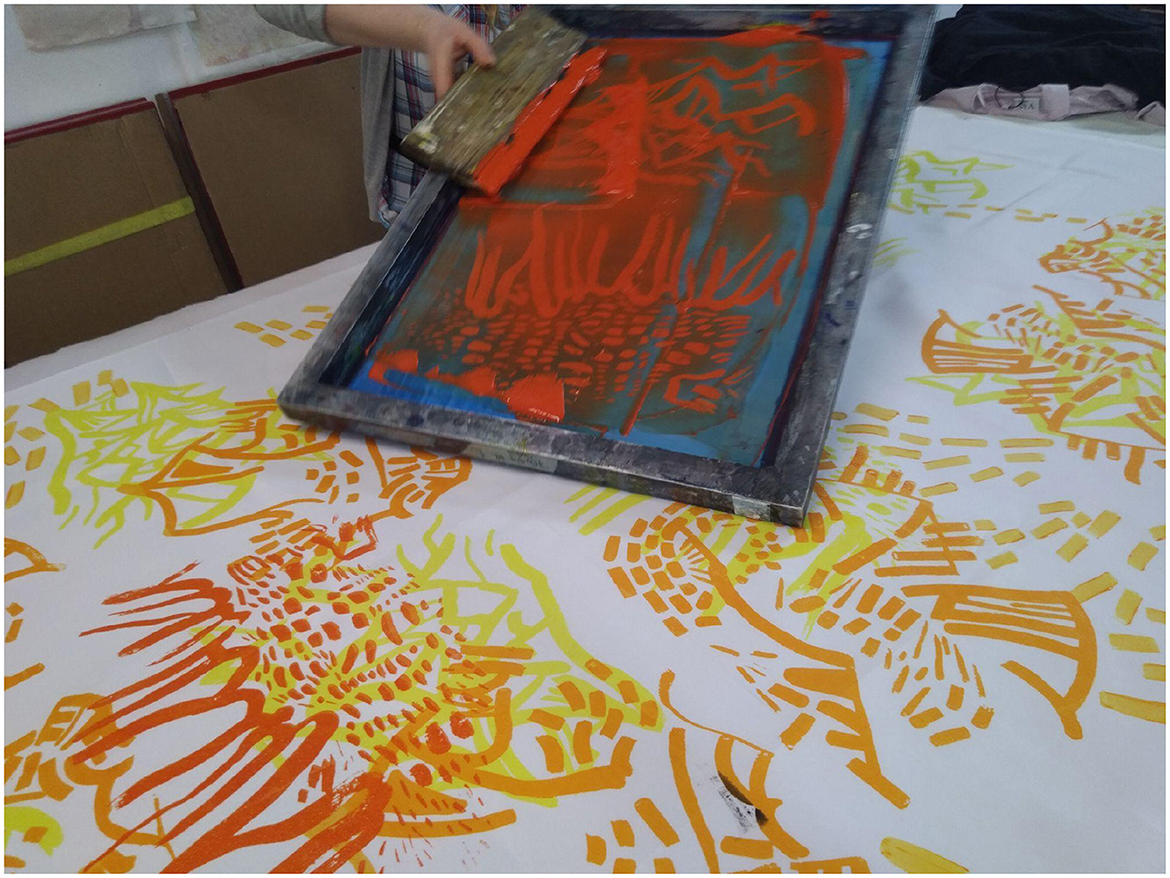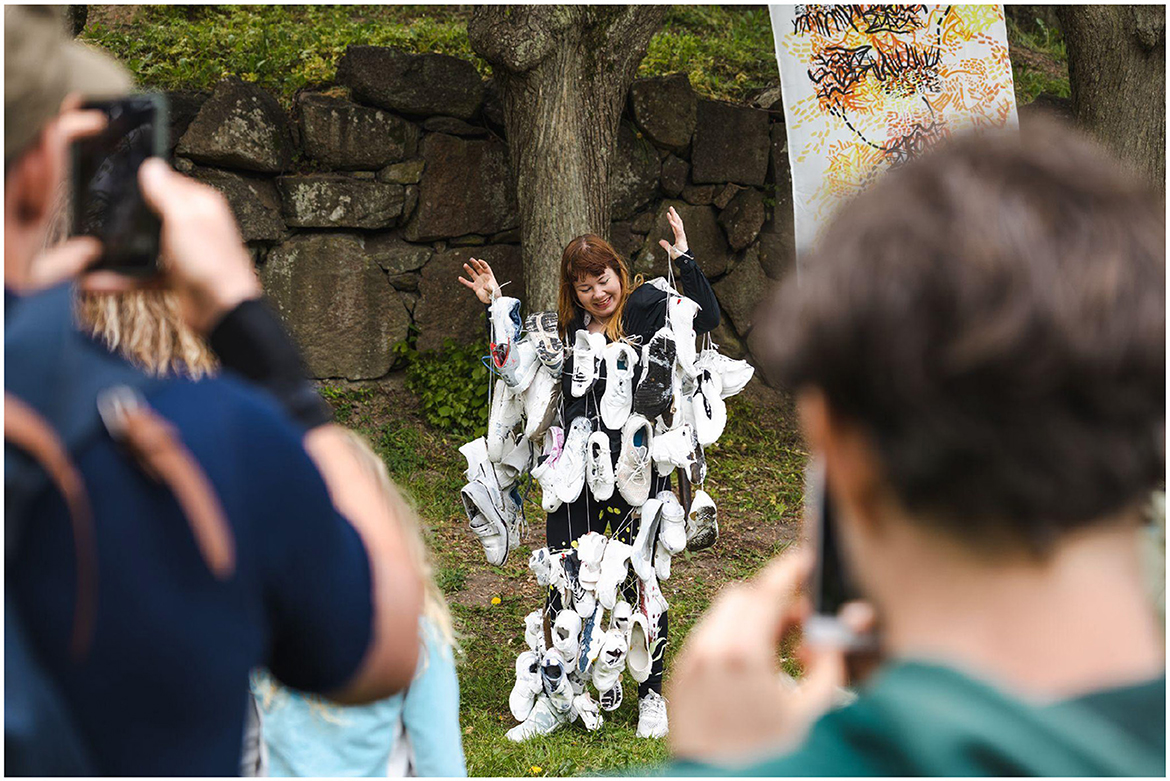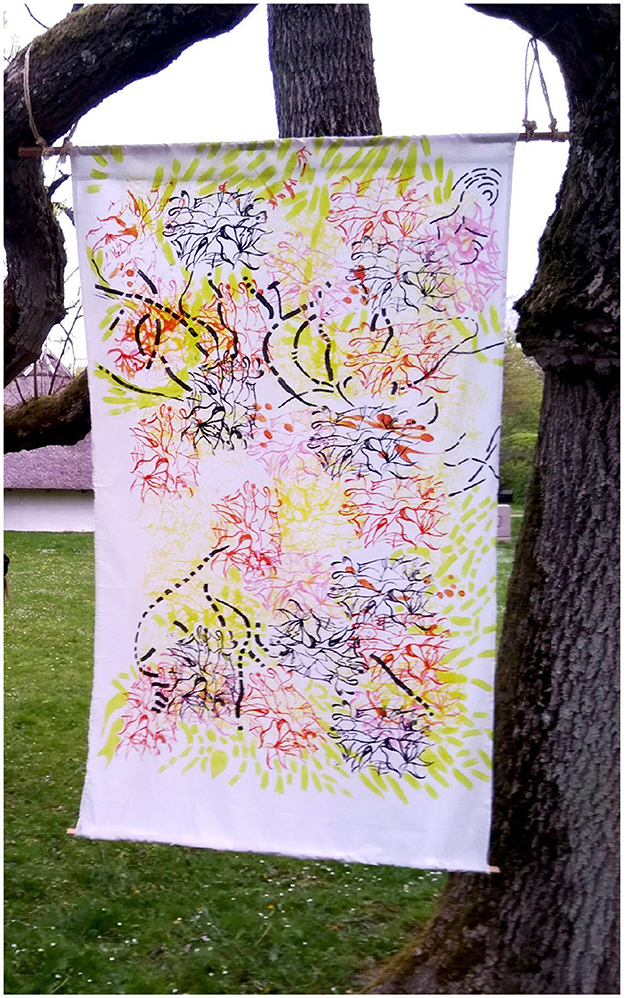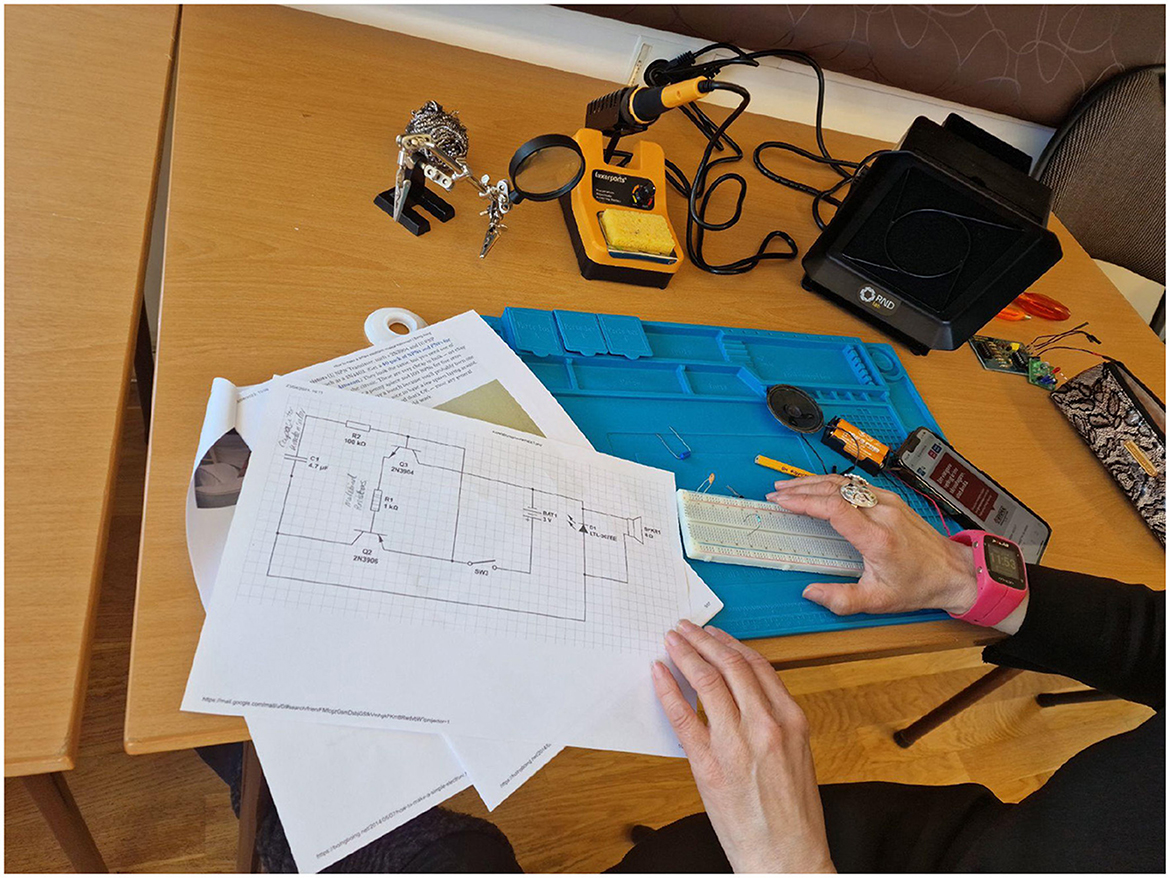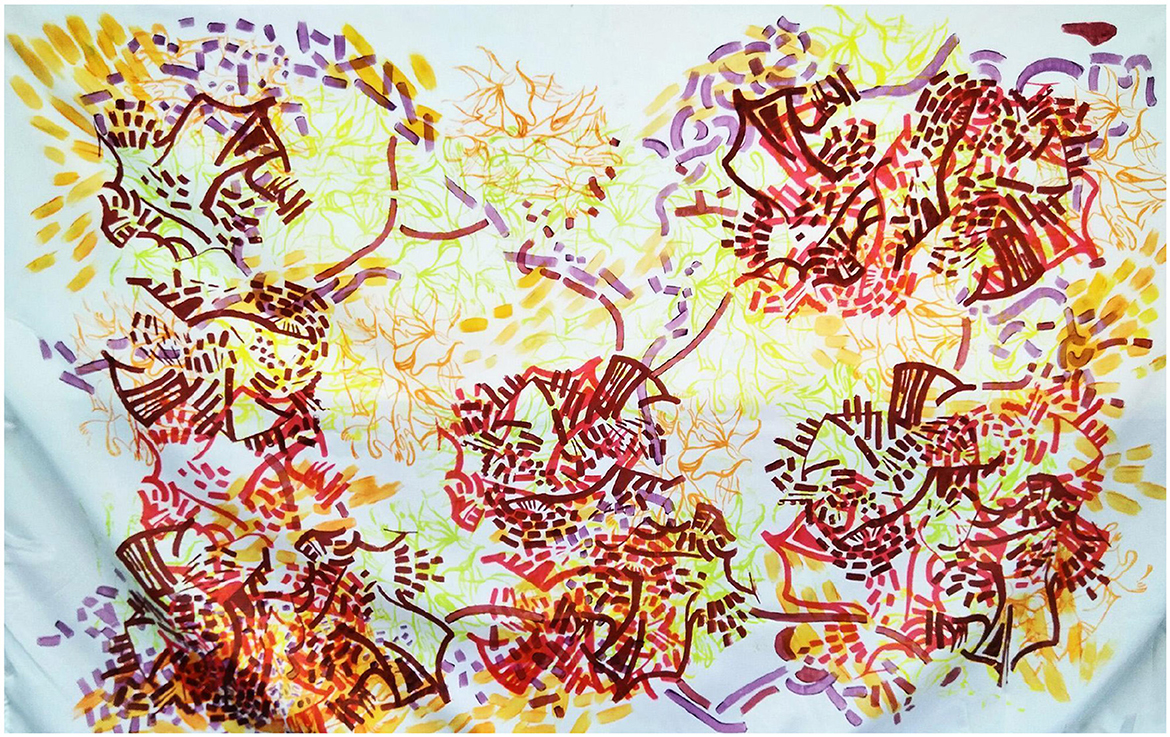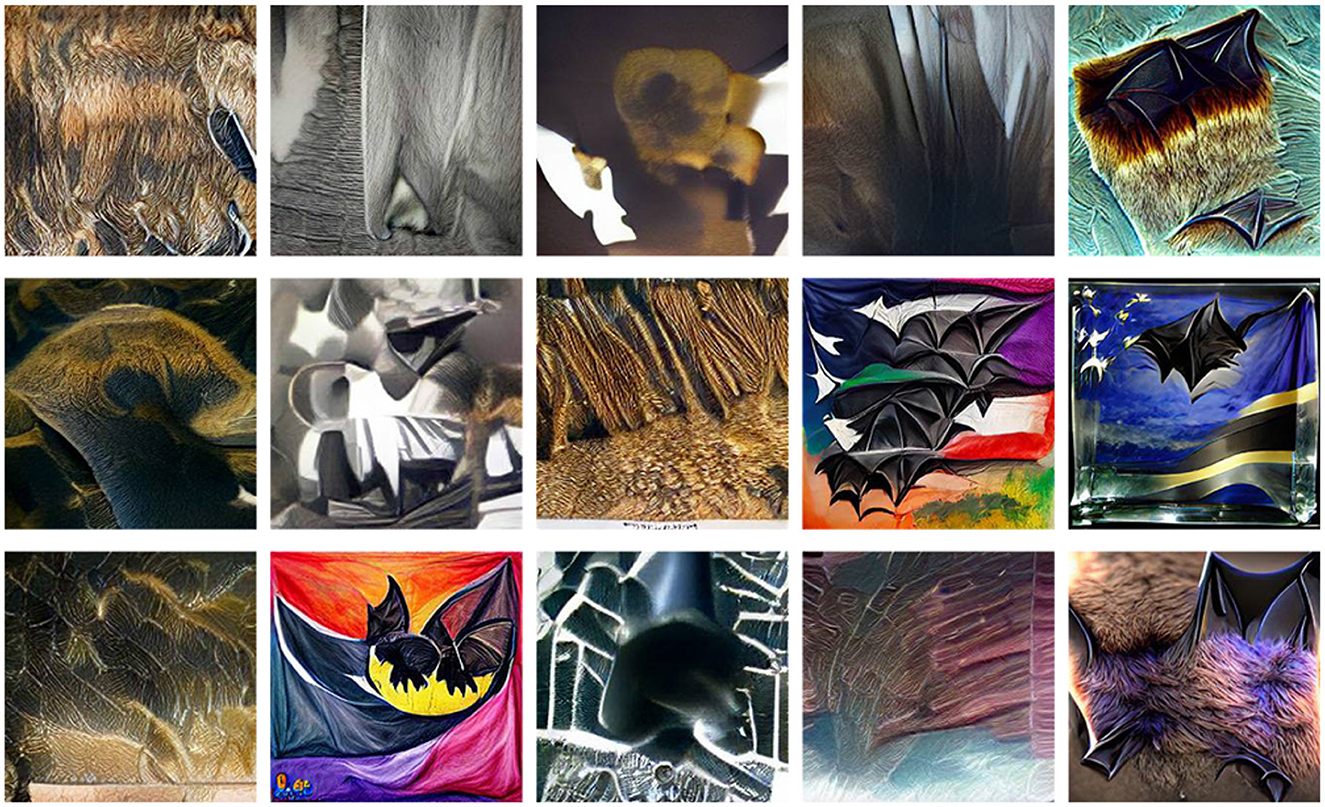- Textile Art and Design Department, Vilnius Faculty, Vilnius Academy of Arts, Vilnius, Lithuania
We are living in times of data-driven selves and data-defined artistic personas, an age in which the action of border-crossing has become a normative within an artistic work and an artist's life. We might cross the physical borders or the borders of our normatives. Each case of border-crossing awakens our awareness. The question of how an artwork is made is now as sharp as ever before. Contemporary technologies involving AI are opening a wide spectrum of possibilities for enhancing creativity and sustainability within the creation of performance artworks, which is traditionally seen as an individual process of a human creator. The main research question within this study is as follows: How can performance and workshop creation through collaboration between humans and AI and humans and technology be understood as post-humanist artistic research? The sub-question is: How is such a creation process different from artistic creation using traditional tools associated with artistic work? These questions are answered by investigating a case of Techno-Lab in Sapmi and a performance artwork creation process through the method of post-humanist artistic research. The key findings outline the main differences of post-humanist vs. anthropocentric artistic research and art production. The findings can be used to change the current normatives and enhance the radical transcorporeality through interconnections between humans and non-humans—in particular, technology and AI. The findings are relevant to art education and artistic practice representatives.
1 Introduction
Artistic production involving technology has begun to enter the dimension of post-humanist discussion (Braidotti, 2013). Likewise, within artistic research extending the normatives of performance production in a collaboration between the artist-researcher and AI, the methodology becomes a post-humanist (Ulmer, 2017) artistic research methodology. Artistic production thus enters a completely different flow of creativity than the process by which the artist uses traditional tools to create an artwork. When an artist works with AI while creating the script and scenography for the performance, AI becomes a non-human collaborator rather than a tool (for example, a brush while one paints). However, the author of the artwork remains the artist, not the AI. This brings up the primary research question (How can a performance created through a collaboration between humans and AI be understood as post-humanist artistic research?) and the sub-question (How is such a creation process different from artistic creation using traditional tools associated with artistic work?).
This article aims to define the key points of how the process of artistic creation with AI is different from artistic creation using traditional tools associated with artistic work. Definitions will be given specifically for the work toward performance production. The objectives of the present work are as follows: to define post-humanist artistic research involving AI, to analyze the case of performance production through the perspective of post-humanist artistic research, and to define the main points on how such artistic research is different from anthropocentric artistic research.
This article suggests a new understanding of the artistic processes, by which technology and human activities are not contrasted as the master and the tools for the master's actions; instead, they are collaborators, imparting input to each other such that the artistic creation takes the shape of the creative loop (Griniuk and Mosich, 2022) from human to technology and from technology to human.
2 Post-humanism, AI, and performance are all interconnected
Although the rapidly changing technological possibilities outline the new procedures for artistic production, it seems that the methodologies of artistic research are a step behind the actual processes in art, particularly performance production. This statement is based on the research of scholars like Donnarumma (2019) and PhD Cand Ilja Mirsky.1 These two authors, in my interpretation, base their mission on the post-humanism in the description by Braidotti (2013). Although the number of examples could be widely extended, it has become more usual now than, for example, in the last decade to involve AI in creative processes, and there is little understanding of precisely how this impacts the holistic methodology of such artistic research (and artistic production). So, the post-humanist take on artistic production can be defined from Braidotti (2013)'s perspective as something that “indicates and actualizes the relational powers of a subject which is no longer cast in a dualistic frame, but bears the privileged bond with multiple others and merges with one's technologically mediated planetary environment” (p. 92). This statement is connected to her discussion on “becoming a machine” (Braidotti, 2013), which, in my opinion, stands most radically aside from the anthropocentric way of thinking. “Becoming a machine” would question the authorship of collaborative work by humans and AI to a large extent and would explain how this collaboration is different from other creative processes involving an artist and a traditional tool for creation. Generative artificial intelligence (AI) builds around algorithms (such as ChatGPT) that can be applied to generate, for example, a new text, based on provided input.
As this paper focuses specifically on performance, we stress the importance of understanding performance on a wide scale. Performance can be analyzed in a variety of ways. Further, anything can be analyzed as a performance. Some of the most common ways to analyse performance are based on Goffman (1990)'s theories of performance, originally from 1959, which later became the background for Schechner (1977)'s method of understanding performance. These theories have impacted the understanding of performance by contemporary performance researchers, which could be exemplified by Philip Auslander in Cecchi (2021), explaining the foundations of his understanding of performance. Both Goffman's and Schechner's theories provide an overview of how performance functions in the world and how it is performed and interpreted by audiences. When one thinks about performance, the first thing that comes to mind is often the theatrical performance of actors on a stage. However, in the most basic sense, the term performance can be used to describe any instance in which a person or group performs a certain action or behavior. This is the way we suggest a performance should be seen to unfold the contemporary discussions about this media in ever-changing societal contexts.
As the main focus of this paper is AI, we will explain exactly how AI is involved in our work. AI, in this paper, is used in a general colloquial sense and refers to current technologies, mostly based on machine learning and neural networks, which are available for a general audience to interact with. More specifically, GPT-3, accessed through the AIDungeon service, was collaborated with, as well as the free image generating services hotpot.ai and huggingface.co. I intend for this paper, through the connection of three main themes of post-humanism, performance, and AI, to fill the gap within methodology studies by addressing the necessity to reconsider methodologies along with the changing relationship between the entities of performance production.
3 Post-humanist artistic research methodology for performance
Artistic research suggests a processual take on artistic production, by which the produced artwork assumes a format of investigation (Jones, 2006). Here, artwork can be interpreted as a case, though the term case comes from the social sciences. In this article, the investigated performance is addressed interchangeably as a performance artwork and as a case. Artistic research seeks to unfold possibilities for innovation within the artistic field (Busch, 2009). In this way, I suggest that reframing the perspective of artistic research and artistic production from an anthropocentric to a post-humanist one is in line with radical innovation (Trott, 2017). This provides new horizons and challenges in defining the new role of the human artist in transcorporeal collaboration (Griniuk, 2021), how to define authorship, and how such a new take on the process of art can impact the skillset training for artists within art academies and universities. Uniting the definition of artistic research with the theoretical definition of posthumanism by Braidotti (2013) and expanding it such that post-humanism is seen as a methodology (Ulmer, 2017), I suggest that the current study is developed through the methodology of post-humanist artistic research. Post-humanist theory refers to a philosophical and critical framework that challenges traditional human-centered (anthropocentric) views of knowledge, and creativity (Alneyadi et al., 2023). In the context of education, post-humanist theory would suggest that intelligent applications (such as Alef, Connect, and Boclips) are not just tools for improving student performance but active participants in the learning process (Alneyadi et al., 2023), where Tashtoush et al. (2023) extends the discussion about the positive impact of Information and Communication Technologies (ICT) on the learning process. Post-humanism would frame these smart applications as co-creators of knowledge, enabling students to interact with scientific ideas in ways that extend beyond human capabilities alone (Alneyadi et al., 2023). Augmented Reality (AR) is as well defined as an active agent in reshaping learning and human interaction with knowledge (Hidayat and Wardat, 2023).
The artistic data were collected throughout 3 months of project planning and 2 months of its implementation. The hermeneutic approach to qualitative data analysis was employed as outlined by Thomas (2006). Thomas argues that traditional qualitative research methods such as grounded theory, phenomenology, discourse analysis, and narrative analysis may not always be suitable for all types of qualitative data. Consequently, he introduces general inductive analysis, a method that aligns with hermeneutic philosophy and is particularly effective for analyzing artistic data. General inductive analysis involves the systematic analysis of qualitative data based on specific research objectives, allowing insights to emerge directly from the raw data without being constrained by rigid methodological frameworks. This approach was applied to interpret the findings from the raw data gathered during the research.
The analysis was conducted within the hermeneutic framework, adhering to the guidelines provided by Gadamer (2004) and Thomas (2006). The data were analyzed by identifying key themes from the visual and aesthetic elements of the principal investigator's (PI's) performance production, as well as from notes taken throughout the process. These keywords were linked to the creation and presentation of the artworks and their symbolic meanings, including the scenography. The post-humanist themes are evident in the keywords, reflecting the collaborative nature of the creative process between human and non-human agents.
4 Unfolding the process behind Techno-Lab in Sapmi, Sami center for contemporary art in Karasjok
This section seeks to delve into the convergence of traditional Sami art, the surrounding natural environment, and state-of-the-art technology. It does so by initiating an innovation project, Techno-Lab Karasjok, situated at the Sami Center for Contemporary Art. The primary goals of the workshops are to establish Techno-Lab as a pioneering laboratory in Karasjok for techno-art exploration and to involve the local community, Sami artists, and curators in this creative process.
The case outlines the specific techniques and tools to be employed in the workshops, along with details regarding the timeframe and location. Drawing insights from the workshop data, the study aims to elucidate the interplay between human, nature, creativity, and technology in Sapmi. Furthermore, it endeavors to showcase how technology can enhance traditional creative processes. The research aspires to make a meaningful contribution to the realms of Sami art, technology, and creativity by innovatively incorporating technology into traditional Sami art practices while fostering a connection with nature and unfolds the core of the post-humanist vs. anthropocentric artistic research and art production. Techno-lab suggests a non-traditional take on artistic creation in the context of Sami creativity. Anyway it connects to the statement of the Sami artists, such as Per Isak Juuso, who already connects traditional duodji technique with the use of plastic and other non-traditional materials in the context of the introduction of his work as diadda-duodji.
5 Unfolding the process behind the performance “Interspecies talk in the shade of the manor”
For this case, the process of production is used in connection to the project “Interspecies talk in the shade of the manor,” realized for the Hollufgård Sculpture Park in Odense in Denmark. The project evolved from the connection between the post-humanist, technological (AI in particular) take on production and the local narrative about the former wine cellar construction on the territory of the park to the left of the manor of Hollufgård.
The connective points between these two angles of the thematic approach, all of which are within the philosophical framework of post-humanism, were as follows. The wine cellar was, according to the local narrative, used for different purposes: the storage of food and non-food, along with other objects and items. The bats most likely are a species that has always been around, or, as it is now, inhabit the spaces inside the construction. So, the interconnected stories within the narrative were the wine cellar, the bats, the technology, and the shoes. The shoes came into the narrative mostly due to the time of performance production. Since the war in Ukraine started, the PI has worked volunteer jobs sorting clothes and shoes in Denmark to be sent to Ukraine. The shoes that were not part of a pair were taken by the PI, and she created a costume out of them. Parallel with this, the shoes came in as a multilayered metaphor for the narrative.
A self-containing performance was developed as well as a one-time performance performed by the PI during the opening event of the artwork. In the self-containing performance, the people can experience the performance without the artist present by walking to the spots and scanning the QR codes (Figure 1). In this way, the audience members themselves take on the role of performer to whatever degree they wish.
Three silkscreen flags printed on thick fabrics with water-resistant silkscreen colors for textile were placed at the three locations. The images contain AI-generated images (Figures 2–4) themed around the narratives about the body of a bat. The images were the basis for drawings made by the PI and printed by the silkscreen technique (Figure 5) in the size of approximately 2.5 m × 1.8 m. A QR code (Figure 1) incorporated into the installation leads to the soundtrack.
The sound consists of two elements. The first element is the recordings of the sounds of bats, which humans normally cannot hear due to the sound frequencies they create. By modulating the recordings of bats, the sounds become audible to the human ear. The second element is the story/narrative/manuscript in three parts, generated by AI and edited by PI. The story is not sequential, so the participants can start and end anywhere they want. In the PI's live performance (Figures 6, 7), the three story parts were used as the basis for an improvised story.
5.1 Analysis of Techno-Lab Karasjok
The project, initiated in March 2023, involved various uses of Techno-Lab Karasjok during the same year. Techno-Lab served as an experimental space, particularly within the Sami Curator Educational program. Additionally, it functioned as a venue for exhibition communication, exemplified in workshops tailored for children. Furthermore, Techno-Lab Karasjok was utilized as a space for repairing activities.
The ongoing findings highlight the diverse applications of Techno-Lab, including practice-based activities that complement theoretical content for adults, explorative and performative space-building workshops inspired by Lena Stenberg's exhibition for children, weekend drop-in sessions, and functioning as a repairing station.
5.2 Analysis of the performance
In the presented case, AI was employed in several ways: to generate images related to bats and to write three short stories with bats as a recurring theme.
The generated images (Figure 2) can be described as a series of abstract images or collages that contain or are made up of elements or parts of images of bats; for example, bat-like wings and fur elements can be identified. The human artist then made drawings consisting of similar bat-like elements; these drawings were then screen-printed onto white fabric in a collage-like manner (Figures 5, 8, 9). On these flags, bat-like elements are still visible, perhaps further abstracted with line-art in bright colors. Also, new elements have been introduced in the form of lines and dots. The collage-like appearance of the flags was made more pronounced by the conditions in the printing studio, where the small screens necessitated repeating several smaller images to cover the large pieces of fabric.
The process of writing the textual pieces is described in the work of Griniuk and Mosich (2022) and consists of the human artist providing a number of written lines to inspire the AI. The AI then outputs further lines, which the human selects and edits. In this case, some themes were provided by the human—such as bats and shoes—while other themes—such as echoes—and connections between themes—such as shoes to a presence, bats being heard but still unheard—were created by the AI.
A more in-depth analysis could take into account deadlines, funding and monetary issues, social conditions, health, and various other things. However, this brief analysis does highlight that the output from the AI becomes entangled with the output of the human, and the origins of certain ideas become difficult to map. Of note is that this entanglement happens not only at the production level but also at the conceptual level—AI output affects ideas early in the process that inform the entire concept and process. For example, the choice of a collage of parts was affected in the conceptual stages by the AI-generated images and in the production stage by conditions in the studio. The point here is that the former can be considered a creative choice and the latter one of necessity. In this way, it becomes difficult or even impossible to differentiate between creative, non-compulsory choices originating from the human or the AI.
5.3 Meta-analysis of Techno-Lab Karasjok
Much like the nuanced perspective in the discourse on AI and human interaction, the project positions Techno-Lab as more than a mere space for experimentation, exhibition communication, and repairs. Rather, it emerges as an enabler and catalyst in the creative process, to a creative assistant in the human-technology dynamic. Specifically as the extension of the communication and exhibition dissemination space Techno-Lab with the content of experimentation for example with DIY instruments within the exhibition space, ads creative dynamics which allows for exploration of the exhibition in a new way.
Techno-Labs facilities become an active participant in shaping the exhibitions communication, and outcomes. The varied applications, from practice-based activities for adults to explorative workshops for children and even functioning as a repairing station, demonstrate the dynamic relationship between the space and its users.
Techno-Lab is not merely a physical space but an active contributor to the artistic endeavors undertaken within it. This dynamic interaction mirrors the intricate dance between human interpretative abilities and technology as the added layer of enhancement of creativity, creating a space where each entity's strengths contribute to a richer, more collaborative creative process. Therefore Techno-Lab project can be discussed in the context of post-humanist artistic research.
5.4 Meta-analysis of performance
Viewing the interaction between AI and a human as merely an interaction between a tool and a creator or master greatly reduces the intricacy of the interaction. An anthropocentric view of this interaction ignores the impact and inspiration possible in the creative feedback loop (Griniuk and Mosich, 2022). Conversely, a post-humanist view would see this interaction as something that is much more meaningful than a mere interaction from the perspective of a tool and creator. It would acknowledge the potential for creative growth that can exist between the AI and the human creator. The AI and the human could both grow by influencing each other's creations or output. Whether this growth or feedback occurs on the smallest scale or the largest scale, the AI and the human are still the co-creators of each other's creations; they both play an active role in the creative feedback loop. As such, the AI is just as involved in the creative process as the human. In this way, the AI is much more than a tool, such as a paintbrush or a hammer. The AI is an enabler and a catalyst in the process of creation.
It does not follow, however, that AIs are creative in the same ways that humans are, nor would they necessarily need to be. In this case, the AI's role could perhaps be termed as a creative assistant as it uses data to inform and inspire the creative process.
It also does not follow that the AI possesses agency in the same way a human might. However, the AI is participating in the process of creating. Thus, the creative feedback loop occurs in this situation only because the AI is participating in the creative process along with the human. The AI, in its role as a creative assistant, then, could be seen as having agency by facilitating the creative process. If we are to attempt to understand or describe this creative process, labeling AI as a tool becomes reductive and simplistic.
The human-AI interaction can therefore be seen as a dynamic relationship between two entities, each with its own strengths and weaknesses. The human is better at interpreting and understanding data, while the AI is better at processing large amounts of data. The human is better at understanding complex ideas and abstract concepts, while the AI is better at performing specific tasks.
5.5 Critical analysis
The cases illustrates that the human-AI relationship in artistic creation is more symbiotic and complex than typically portrayed. AI is not just a tool but a creative partner that influences both the conceptual and practical stages of art-making. While AI lacks human-like agency or creativity, it facilitates new forms of creative expression through its ability to process data and inspire unexpected thematic connections. This shifts the discourse from a master-tool dynamic to a co-creative partnership that enriches the artistic process. Anyway this post-humanist creative process raises as well the questions of ethics and authorship behind the created artwork.
5.6 Perspectives in educational context
The current paper focuses on performance and technology, aligning with theoretical discussions about intelligent applications as tools for enhancing the learning process (Alneyadi et al., 2023; Tashtoush et al., 2023) and Augmented Reality (AR) as an interactive element in teaching environments (Hidayat and Wardat, 2023). It also examines the role of AI in academic settings as part of the post-humanist sphere of artistic creation. The introduction of courses that enhance students' digital literacy, consciousness, and critical thinking when working with technology—particularly AI—could address emerging questions such as authorship and law when creating the artwork involving human and non-human creators, and the ethical considerations in collaborating with non-human entities. These aspects could significantly enrich students' critical thinking skills.
6 Conclusion
This article addresses post-humanist artistic research by using performance artwork production as a research case to outline the main points of value of collaboration between humans, technology and AI and the new scale of the artistic, creative loop that such collaboration causes. The anthropocentric way of understanding artistic production needs to shift into the post-humanist perspective, as newly available technology provides new ways of experiencing creativity. Technology within Techno-Lab project and AI within performance production can be seen as an assistant that inspires and gives input, which the creative producer applies or edits and gives back to. Such production is cyclic and mutually impacts the output. The perspective of tool and creator is thus expanded to the scale of giving inspiration and being inspired as humans and technology interchange these roles. In other words, technology and AI is an accelerator of the creative process, not just a tool. Technology and AI can be interpreted as a co-collaborator and co-participant in the creative process, yet this collaboration is not equal, as the human creator makes the final decisions about the aesthetic outcome. All these points suggest that artistic creation and artistic research should be reframed in a post-humanist framework, as the anthropocentric take on these processes is no longer useful when interconnecting technology in the exhibition facilitation processes and exhibition dissemination and AI with performance. Post-humanist artistic research allows for an understanding to emerge of co-creation with technology and AI as a dynamic process between the two entities. So, post-humanist artistic research can allow for transcorporeal artistic production and could be a useful methodology, while technological possibilities expand on a level available to consumers. The findings of this research, which outlined the main points that define the post-humanist artistic research, can be useful to the art academy and university educational milieus and to artist-practitioners.
Data availability statement
The original contributions presented in the study are included in the article/supplementary material, further inquiries can be directed to the corresponding author.
Ethics statement
Written informed consent was obtained from the individual(s) for the publication of any potentially identifiable images or data included in this article.
Author contributions
MG: Writing – original draft.
Funding
The author(s) declare financial support was received for the research, authorship, and/or publication of this article. This research project by Marija Griniuk was funded by the Research Council of Lithuania (LMTLT) under agreement no. S-PD-24-49.
Conflict of interest
The author declares that the research was conducted in the absence of any commercial or financial relationships that could be construed as a potential conflict of interest.
Publisher's note
All claims expressed in this article are solely those of the authors and do not necessarily represent those of their affiliated organizations, or those of the publisher, the editors and the reviewers. Any product that may be evaluated in this article, or claim that may be made by its manufacturer, is not guaranteed or endorsed by the publisher.
Footnotes
1. ^Being a young scholar, Ilja Mirsky, whom Griniuk had the pleasure of meeting in August 2021, actively works toward erasing the barrier between performance and technology – for example, during his workshop in Finland. Available at: https://opinto-opas.uniarts.fi/en/course/T-XD119/13210.
References
Alneyadi, S., Wardat, Y., Alshannag, Q., and Abu-Al-Aish, A. (2023). The effect of using smart e-learning app on the academic achievement of eighth-grade students. Eurasia J. Mathem. Sci. Technol. Educ. 19:em2248. doi: 10.29333/ejmste/13067
Cecchi, A. (2021). Performance/media/documentation… thinking beyond dichotomies. An interview with Philip Auslander. Sound Stage Screen 1, 243–264.
Donnarumma, M. (2019). Writings. Marco Donnarumma. Available at: https://marcodonnarumma.com/writings/ (accessed June 01, 2022).
Goffman, E. (1990). The Presentation of Self in Everyday Life. London: Penguin Books. (Original work published 1959).
Griniuk, M. (2021). Performance art using biometric data. Art History Crit. 17, 101–112. doi: 10.2478/mik-2021-0009
Griniuk, M., and Mosich, T. B. (2022). “Transcorporeal writing: the interconnectedness between random stimuli in enhancing creativity training and the involvement of AI in the practice of writing,” in Proceedings of Carpa7.
Hidayat, R., and Wardat, Y. (2023). A systematic review of augmented reality in science, technology, engineering and mathematics education. Educ. Inform. Technol. 29, 9257–9282. doi: 10.1007/s10639-023-12157-x
Jones, T. E. (2006). The studio-art doctorate in America. Art J. 65:124. doi: 10.1080/00043249.2006.10791208
Tashtoush, M. A., AlAli, R., Wardat, Y., Alshraifin, N., and Toubat, H. (2023). The impact of information and communication technologies (ICT)-based education on the mathematics academic enthusiasm. J. Educ. Soc. Res. 13:284. doi: 10.36941/jesr-2023-0077
Thomas, D. (2006). A general inductive approach for analyzing qualitative evaluation data. Am. J. Eval. 27, 237–246 doi: 10.1177/1098214005283748
Trott, P. (2017). Innovation Management and New Product Development (6th ed.). London: Pearson Education.
Keywords: transcorporeality, creativity, performance art, workshops, AI, technology, Sapmi
Citation: Griniuk M (2024) Post-humanist artistic research by production of performance and Techno-Lab workshops in Sapmi. Front. Commun. 9:1426522. doi: 10.3389/fcomm.2024.1426522
Received: 01 May 2024; Accepted: 05 November 2024;
Published: 28 November 2024.
Edited by:
Heidi Pietarinen, University of Lapland, FinlandReviewed by:
Yousef Wardat, Yarmouk University, JordanDomenico Tangredi, Imaginary Institute, Italy
Copyright © 2024 Griniuk. This is an open-access article distributed under the terms of the Creative Commons Attribution License (CC BY). The use, distribution or reproduction in other forums is permitted, provided the original author(s) and the copyright owner(s) are credited and that the original publication in this journal is cited, in accordance with accepted academic practice. No use, distribution or reproduction is permitted which does not comply with these terms.
*Correspondence: Marija Griniuk, bWFyaWphLmdyaW5pdWtAZ21haWwuY29t
 Marija Griniuk
Marija Griniuk